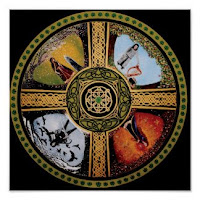c1000 BCE TUATHA DE DANANN followers of the Goddess Danu/Dana and early occupants of Ireland will be taken over by Celtic invaders, sometime in the 4th century BCE, (21a) perhaps by Milesians from Spain and of Cretan origin. The Tuatha had four treasures, known as the Four Treasures of Ireland and nominated as magical emblems of the Tuatha gods. The Four Treasures are the ‘Cauldron of the Dagda’, father of all; the ‘Spear of Lug’; the ‘Sword of Nuada’; and the ‘Stone of Fal’. (10)
LUGH of the Long Arm a hero who comes to live among the Tuatha de Danaan. His face shone like the sun. He wore a silver chain, token of the Milky Way running across the heavens, he carried the seven-coloured rainbow, his sword was called ‘Answerer’, and his boat the ‘Wave-Sweeper’ was inherited from the god of the Ocean. [371]
The Celtic race probably originated in France (Gaul) before expanding throughout Europe (Germany and Britain) and the Middle East in the latter part of the first millennium BCE, thus they ranged across Europe from the Caspian mountains to Ireland. Eventually the Celts will be repulsed by the Roman and Germanic tribes and withdraw into Gaul by 1st century BCE, although they will remain a heavy influence in Ireland and Britain for much longer. (13) After being beaten by the Romans in the future, the Celts will gradually be converted to Christianity in the 5th century CE. (9)
Celtic society is divided generally into three classes:- the priests and priestesses called Druids and Dryads, the warriors, and the common people or serfs. Teachings and philosophies of the priest cast were not recorded but transferred by oral teaching, as in the case of many ancient peoples including the Hebrews. It is known from archaeological research that the Celts, or rather the priestly Druids and Dryads, understood and applied astronomical and mathematical knowledge. (9)
The priestly cast in old Irish are called Drui and are followers of the Moon Goddess Artemis. The priestesses reigned supreme in the first matriarchal phase of the Druidic cult but later the male Druids as priests of Be’al, the one god identified with the sun, takeover in the second patriarchal phase of the cult. Generally, as bardic wizards, the priestly cast kept the oral tradition alive to eventually form the nucleus of future medieval sagas, epic, and ballads, such as those of King Arthur. (13. 28)
Celtic knowledge will descend through the generations in knowledge of the Four Seasons and the Four divisions of the solar year. These are celebrated in the Spring Rite of flowering EARTH at Beltane, the Summer Rite of the heat or FIRE at Lammas, the Autumn Rite of WATER at Samhain and the Winter Rite of the new light of AIR at Candlemas.
Towards the end of this millennium waves of migrant peoples now begin to bring new cultural influences into Spain and Europe. Celtic people speaking an Indo-European language spread their culture, and settlers from more advanced civilizations establish towns along the Mediterranean coast: Phoenicians at Cadiz, Greeks at Malaga and Ampurias, and Carthaginians at Cartagena. (102)





No comments:
Post a Comment